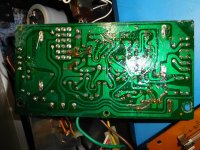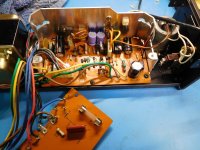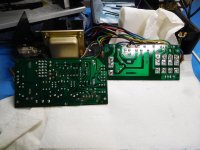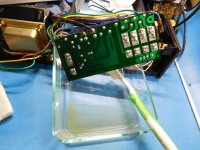ever use the A.R.T. (Italy) solid carbon mat and/or Damper weight from back in the S. Cascianio days of Be Yamamura?
I'm sorry, unfortunately I never had the opportunity to feel these products applied on the platter or see them; of the A.R.T. I only have a carbon platter to apply over the cd disc for better reading of the disc.
Got the PS caps removed and boards cleaned. Someone had added solid wires with some sort of brushed-on coating on top of traces that had no evidence of prior damage, so it seems they thought there was more current present than the boards can handle as designed. My guess it's the same person who did a pretty lousy job of replacing some of the caps, leaving long leads under the boards, bad solder joints, and a couple of lifted traces. The smaller value original caps were not replaced, and one of the 100uF/16V was starting to leak at the seal. There was evidence of prior electrolyte leakage at several of the cap locations.
One of the AC wires from the switch was hanging on with two strands, and someone had tried in vain to remove the main filter cap clamp, munching up the screw, so those will be replaced with new stainless hex screws.


Cleaned the acrylic conformal coating off with IPA followed by Crystal Simple Green (unscented, uncolored, commercial version), then water and pressurized air. All the caps are on order, along with a new silicon nitride ball for the bearing and all new fuses.


I tested the original and no-name replacement caps on my LC-102 for value, leakage, DA and ESR, then my TH2832 LCR meter for Q, D and R at 120Hz and 1kHz. The original caps tested very close to their values, but ESR was at the high end on some of the smaller caps, while Q was low on several, and D (dissipation factor) was unsurprisingly high given the age. The main filter cap tested well, but dialectric absorption was getting high at 7%, though leakage was low. However, a few of the no-name replacements tested poorly; low or high capacitance, high DA, high ESR, high D. Again, not surprising.
One of the AC wires from the switch was hanging on with two strands, and someone had tried in vain to remove the main filter cap clamp, munching up the screw, so those will be replaced with new stainless hex screws.


Cleaned the acrylic conformal coating off with IPA followed by Crystal Simple Green (unscented, uncolored, commercial version), then water and pressurized air. All the caps are on order, along with a new silicon nitride ball for the bearing and all new fuses.


I tested the original and no-name replacement caps on my LC-102 for value, leakage, DA and ESR, then my TH2832 LCR meter for Q, D and R at 120Hz and 1kHz. The original caps tested very close to their values, but ESR was at the high end on some of the smaller caps, while Q was low on several, and D (dissipation factor) was unsurprisingly high given the age. The main filter cap tested well, but dialectric absorption was getting high at 7%, though leakage was low. However, a few of the no-name replacements tested poorly; low or high capacitance, high DA, high ESR, high D. Again, not surprising.